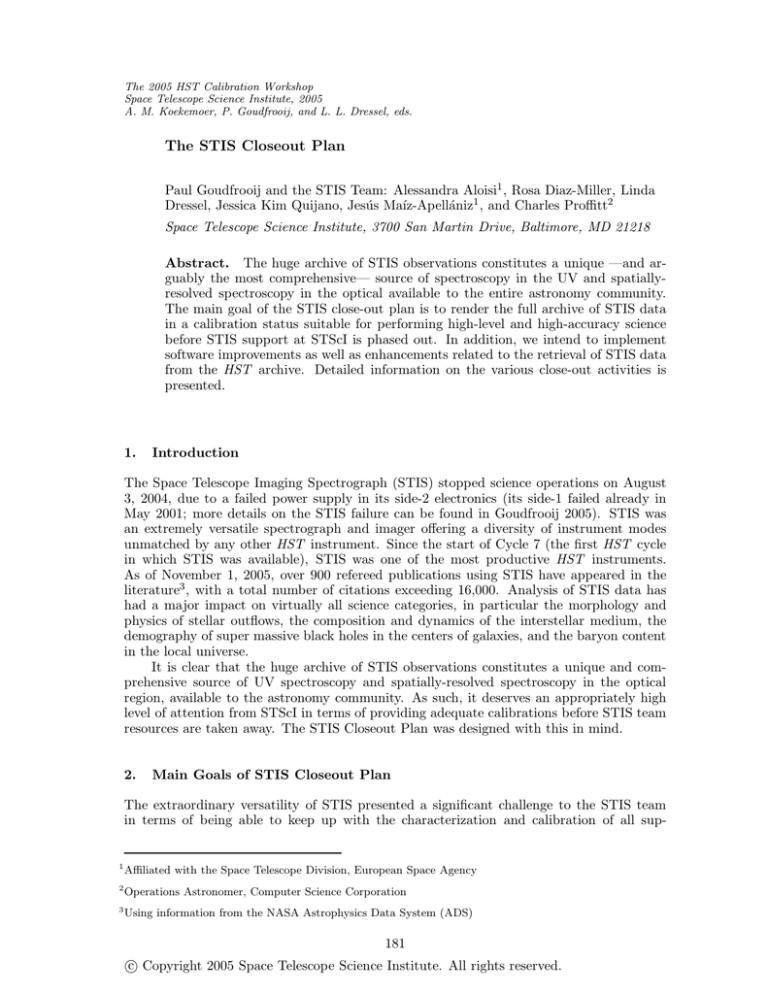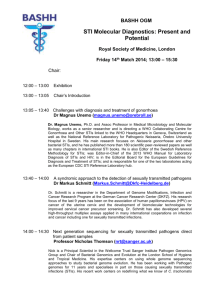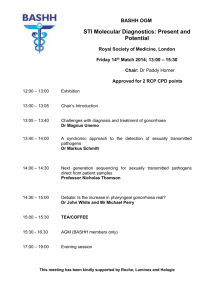
The 2005 HST Calibration Workshop
Space Telescope Science Institute, 2005
A. M. Koekemoer, P. Goudfrooij, and L. L. Dressel, eds.
The STIS Closeout Plan
Paul Goudfrooij and the STIS Team: Alessandra Aloisi1 , Rosa Diaz-Miller, Linda
Dressel, Jessica Kim Quijano, Jesús Maı́z-Apellániz1 , and Charles Proffitt2
Space Telescope Science Institute, 3700 San Martin Drive, Baltimore, MD 21218
Abstract. The huge archive of STIS observations constitutes a unique —and arguably the most comprehensive— source of spectroscopy in the UV and spatiallyresolved spectroscopy in the optical available to the entire astronomy community.
The main goal of the STIS close-out plan is to render the full archive of STIS data
in a calibration status suitable for performing high-level and high-accuracy science
before STIS support at STScI is phased out. In addition, we intend to implement
software improvements as well as enhancements related to the retrieval of STIS data
from the HST archive. Detailed information on the various close-out activities is
presented.
1.
Introduction
The Space Telescope Imaging Spectrograph (STIS) stopped science operations on August
3, 2004, due to a failed power supply in its side-2 electronics (its side-1 failed already in
May 2001; more details on the STIS failure can be found in Goudfrooij 2005). STIS was
an extremely versatile spectrograph and imager offering a diversity of instrument modes
unmatched by any other HST instrument. Since the start of Cycle 7 (the first HST cycle
in which STIS was available), STIS was one of the most productive HST instruments.
As of November 1, 2005, over 900 refereed publications using STIS have appeared in the
literature3 , with a total number of citations exceeding 16,000. Analysis of STIS data has
had a major impact on virtually all science categories, in particular the morphology and
physics of stellar outflows, the composition and dynamics of the interstellar medium, the
demography of super massive black holes in the centers of galaxies, and the baryon content
in the local universe.
It is clear that the huge archive of STIS observations constitutes a unique and comprehensive source of UV spectroscopy and spatially-resolved spectroscopy in the optical
region, available to the astronomy community. As such, it deserves an appropriately high
level of attention from STScI in terms of providing adequate calibrations before STIS team
resources are taken away. The STIS Closeout Plan was designed with this in mind.
2.
Main Goals of STIS Closeout Plan
The extraordinary versatility of STIS presented a significant challenge to the STIS team
in terms of being able to keep up with the characterization and calibration of all sup-
1
Affiliated with the Space Telescope Division, European Space Agency
2
Operations Astronomer, Computer Science Corporation
3
Using information from the NASA Astrophysics Data System (ADS)
181
c Copyright 2005 Space Telescope Science Institute. All rights reserved.
182
Goudfrooij et al.
ported observing modes4 , many aspects of which are/were complex and/or time-dependent.
The main goal of the STIS Closeout Plan is to render the archive of STIS data taken in
‘supported’ modes (plus a subset of the ‘available-but-not-supported’ observing modes; see
Table 1) in a calibration status suitable for performing high-level and high-accuracy science
before STIS support at STScI will have to be phased out for the benefit of new instruments
to be installed in HST Servicing Mission 4. We currently estimate that this phase-out for
STIS support will occur by the end of 2006.
The goal for the final overall level of calibration accuracy to be reached for all (previously) supported STIS observing modes is listed in Chapter 16 of the STIS Instrument
Handbook (Kim Quijano et al. 2004). In addition, we intend to implement software improvements as well as enhancements related to the retrieval of STIS data from the HST
archive. The activities in the STIS Closeout Plan can be divided into one of the following
three main classes:
1. Already planned tasks of moderate-to-high priority which did not yet come to completion. These tasks are related to STIS calibration of regularly used observing modes
and the subsequent implementation into software (within the pipeline or as off-line
IRAF tools) or pipeline reference files;
2. New tasks related to, e.g., the enhancement of archive capabilities regarding STIS
data, or to a proper documentation of all activities regarding the use of STIS data
and of the monitoring activities used by the STIS branch over the years;
3. Tasks related to the implementation by STScI of the software and other deliverables
created by the Space Telescope-European Coordinating Facility (ST-ECF) in Germany as part of its STIS-CE (Calibration Enhancement) project.
In the following sections we will provide the reader with specific, but brief, information
about each ongoing or planned significant activity in the STIS Closeout Plan as of Nov
15, 2005. The activities are organized by main category: Calibration, Pipeline, Archive
Enhancement, and User Information. The overall priority of each activity is indicated after
each title; the priorities were assigned based mainly on two factors regarding the observing
mode involved, namely (i) statistics on its usage, and (ii) the uniqueness of its capability
relative to those offered by other instruments. For the calibration activities, we also list the
ID of the calibration program(s) involved if appropriate.
3.
3.1.
Description of Activities in the Closeout Plan
Calibration Activities
E-Mode Sensitivities (Priority: Crucial): This activity will deliver the final sensitivity calibrations for the echelle modes of STIS. This includes final reference file updates
for wavelength-dependent aperture corrections, wavelength-dependent extraction size
corrections, and wavelength-dependent time dependences, using all calibration data
collected through the summer of 2004. The synphot component files for the echelle
modes also need to be updated (the current versions are not consistent with the photometric sensitivity reference files in the pipeline; e.g., the former do not include the
echelle blaze functions, only the ‘envelope’ of the sensitivity curves). Results of this
activity will be documented in an Instrument Science Report (hereafter ISR, which
are available through the STIS instrument web site at http://www.stsci.edu/hst/stis).
(See Aloisi (2006) in this volume.)
4
The supported set of observing modes included: 3 detectors (fuv-mama, nuv-mama, ccd), 4 operational
modes (acq, acq/peak, accum, timetag), 44 apertures (filters, slits), and 133 grating/tilt combinations.
The STIS Closeout Plan
183
Table 1: Status of and calibration plan for spectroscopic STIS observations taken in
“available-but-not-supported” modea
Observing Mode
a
# exp.
Calibration Plan or limitation of data
Non-recommended echelle
grating + small aperture
combination
21
To be calibrated for final STIS archive
Echelle and first-order
spectra taken with nonsupported aperture
86
Limitations for each grating/aperture combination
will be indicated in final close-out report
First-order spectra taken
with 2×2 or 6×6 aperture
2587
Planning to calibrate for final archive (treated as
slitless for 6×6 aperture).
Spectra taken with unsupported fiducial bars
67
Limitations for each grating/aperture combination
will be indicated in final close-out report
Echelle spectra of extended
objects with long slits
39
Calibration needs to be different for every individual science application. Will stay unsupported.
Spectra in G750L @ 8975Å
or G750M @ 10363Å
3
2nd -order overlap. Will stay unsupported; limitations will be indicated in final report.
There are 3666 spectroscopic science observations in the STIS archive taken in “available” mode (header
keyword cfstatus = ‘available’), which is ∼ 10% of the total.
HST Program Numbers: 8915, 8919, 9628, 10033
E-Mode Sensitivity Uncertainty due to Blaze Shifts (Priority: High): This activity is related to the previous one but is listed separately because it includes the
complicated effort to derive a correction for the so-called Monthly Offsets and their
associated blaze shifts, which do not repeat well for a given month of the year (i.e.,
the time dependence of the amplitude of the blaze shifts is currently not adequately
corrected for). This effort shall be performed for both primary and secondary central
wavelength settings, as they have had similar usage by GOs. This activity will involve
writing at least one ISR, and may involve the need for code changes within CALSTIS.
(See Aloisi (2006) in this volume.)
HST Program Numbers: 8915, 8919, 9619, 9628, 10033
MAMA Full-Field Sensitivity Monitor (Priority: Medium): These activities comprise flux measurements of various isolated stars covering the field of view of the STIS
MAMA detectors, from images that are taken at regular time intervals so that the
same star is imaged on different parts of the detector. These data are used to monitor
the full-field sensitivity of the detectors as well as the astrometric and PSF stabilities.
The data from Cycles 11 and 12 will have to be analyzed. The results will be compared to the previously determined time dependence of the sensitivity for the different
imaging modes, and to evaluate the need for updates to the low spatial frequency flat
fields for imaging modes. This activity will involve writing one ISR.
HST Program Numbers: 9622, 10028, 9623, 10032
MAMA Dark Monitor (Priority: Medium/High): This activity involves the measurement of the dark current levels of the two MAMA detectors, which have been
184
Goudfrooij et al.
taken twice a week for each detector. The NUV-MAMA dark data taken over the
years will be assembled together to determine final functional forms of the global dark
current levels as a function of time, tube temperature, and charge amplifier temperature. These scaling functions will be implemented into the STIS calibration pipeline
(CALSTIS), involving new reference files as well as a code change. In the case of the
FUV-MAMA detector, additional work is needed to determine a better parametrization of the dark level in the “glow” region of the detector. We already have a good
idea on this from earlier preparation work, namely to parametrize the FUV-MAMA
dark level as a function of the time elapsed since the high-voltage was turned on.
For a “heritage” instrument, this can be implemented by delivering a reference table
containing the turn-on times, or as a post-observation tool using another proxy that is
dependent on the time elapsed since the high-voltage was turned on, e.g., the intensity
level of hot pixels. These findings will be written up as two ISRs.
HST Program Numbers: 9615, 10034
CCD Bias and Dark Monitor (Priority: High): This activity involves a thorough investigation of the evolution of the CCD biases and darks as a function of time, including the number of hot columns in superbiases, the level of the spurious change
in superbiases (Goudfrooij & Walsh 1997), and the number of hot pixels in darks at
different intensity levels and as a function of row number (indicating the evolution of
CTE loss). The main purposes of this activity are to provide useful information on
the behavior of the performance of CCDs (of different architecture) in orbit, and to
compare the results with the performance of other CCDs on HST. This activity will
likely involve writing two ISRs.
CCD External Sparse-Field CTE monitor (Priority: High): This activity involves
the analysis of the last two epochs of the External Sparse-Field CTE monitor calibration program. These data bear directly on the influence of CTE effects to the accuracy
of point source photometry and spectroscopy. The analysis has been described before
by Goudfrooij & Kimble (2002). The results will also be compared to those derived
from the physical model of CTE loss of the STIS CCD by P. Bristow of the ST-ECF
(see below). This activity will involve writing two ISRs, and it will also be used in
the final version of a manuscript on the CTE performance of the STIS CCD, to be
submitted to PASP.
CCD CTE effect on Extended Sources (Priority: Med/High): This activity involves the analysis of data observed during three calibration programs to determine the
effects of CTE loss to surface photometry and spectroscopy of extended sources, as
well as the time dependence of those effects: (i) the effects of CTE loss to CCD imaging of galaxies (e.g., luminosity, ellipticity, and position angle measurements at a given
surface brightness), (ii) The effect of CTE loss to continuum fluxes and emission-line
intensities in spectroscopy mode; (iii) The effect of CTE loss to absorption-line intensities, profiles, and equivalent widths in spectra. All results mentioned above will be
compared to the correction applied by the physical model of CTE loss of the STIS
CCD by P. Bristow of the ST-ECF (see below). In addition, the results from (ii)
and (iii) above will also be compared to the CTE correction provided by the STIS
pipeline (derived from point source spectrophotometry). This activity will involve
writing three ISRs.
HST Program Numbers: 8839, 8927, 10038
Imaging Zeropoints and Color Terms (Priority: High): This activity involves the
analysis of imaging data of sources with known photometry and covering a wide
range of (known) SEDs (spectral energy distributions). The analysis will involve
The STIS Closeout Plan
185
deriving the influence of the intrinsic colors to the derived zeropoints (i.e., the so-called
‘color terms’ in the photometric calibration), and a comparison with predictions using
synthetic spectra (using synphot). This activity will involve writing a PASP paper.
(See Proffitt (2006) in this volume.)
MAMA First-Order Dispersion Solutions (Priority: High): This activity involves
the analysis of deep first-order MAMA wavecals taken in the context of a calibration
program. Internal wavecals have been obtained at all primary and secondary central
wavelengths. Exposure times were chosen to yield enough strong emission lines to
constrain adequate wavelength solutions. Data were taken at the zero MSM offset
position which is in the middle of the range covered by monthly offsets, and hence
provides the best average dispersion solution. Dispersion solutions will now be derived
using the recently published Pt/Cr-Ne line list (Sansonetti et al. 2004). (Note that the
current dispersion solutions were derived using a Pt-Ne line list, even though the line
lamps used on STIS were Pt-Cr-Ne hollow cathode lamps). A new dispersion ( dsp)
reference file will be created and delivered. An ISR describing dispersion changes as
well as the accuracy of the previously used dispersion solutions will be written and
published.
HST Program Numbers: 9618
Grating Scatter for the G230LB Grating (Priority: Medium): This activity involves the analysis of measurements of red targets taken with both the G230L grating
(a NUV-MAMA mode) and the G230LB grating (a CCD mode). The goal is to determine a correction for the influence of grating scatter (primarily from the far wings
of the LSF, similar to the effects seen before for the UV gratings used in the Faint
Object Spectrograph (Rosa 1994)) in case of CCD/G230LB spectra of red targets.
This activity will involve communication with M. Gregg (see Gregg et al. (2006) in
this volume) who is working on this issue as well in the context of his STIS SNAP
program.
HST Program Numbers: 7723
Spectroscopic PSF Across Slit (Priority: High): This activity involves the characterization of the PSF across the slit for two commonly used long slits (52x0.1 and
52x0.2). Multiple G750L spectra are taken of a K giant star, stepping the slit across
the star between exposures to sample the PSF along the dispersion direction. For
chosen wavelength intervals, the relative fluxes in each slit position and spectral row
are compared to the values predicted using TinyTim models. It is important to verify these models since they are used as input in the dynamical modeling of spectral
images, e.g., in the dynamical modeling of galactic nuclei. This activity will involve
writing one ISR. (See Dressel (2006) in this volume.)
HST Program Numbers: 9610
Faint Standards Extension (Priority: High): This activity involves analysis of CCD
spectra of (faint) white dwarfs which were previously identified and verified as bona
fide spectrophotometric standard stars. The purpose of this analysis is to provide
a thorough verification of the previously established CTE corrections for CCD spectroscopy, namely by stepping the target along the slit (5 positions) with two (short)
exposure times. This will verify the results using the two-amplifier readout method,
and provide high-S/N data at low intensity levels and low background level. This
activity involves the writing of one ISR and may also involve an update of the CTE
parameters in the CCD Table Reference File, if necessary. First results from this
activity are shown in this volume (Goudfrooij & Bohlin 2006).
HST Program Numbers: 10037, 10039
186
Goudfrooij et al.
Trace Stability for Often-Used Modes (Priority: High): Spectral “trace” reference
files prescribe the projection of spectra onto the detector at a given position along the
spectrograph slit. They are used to produce rectified spectral images and extracted
spectra. Accurate traces are needed when individual rows in spectral images are to
be analyzed – e.g., in kinematic studies of galaxies, designed to measure the masses
of supermassive black holes in galactic nuclei. Accurate traces are also needed for
photometric accuracy when small extraction boxes are required to separate nearby
point sources or to better isolate a point source from more extended emission. The
spectral traces now in use were created from inflight data taken early in the orbital
lifetime of STIS, and they can be seen to be in error in rectified spectral images taken
in the last few cycles. This project will use calibration as well as GO data to derive
spectral traces near the center of the detector (and, for CCD observations, at the E1
aperture positions), for the most commonly used gratings and central wavelengths at
several epochs. We will examine changes in rotation and shape of traces, and produce
new reference files where needed. The highest-priority grating settings, selected by
total science observing time, are all L gratings as well as G750M at central wavelengths
6581, 6768, and 8561. Apart from the creation of calibration reference files where
needed, this project will involve the writing of an ISR. (See Dressel et al. (2006) in
this volume.)
3.2.
Pipeline Activities
Rectification of Non-Dithered Spectra of Spatially Resolved Targets (Priority:
High): This activity is to improve the quality of 1 – 3 pixel high extractions of STIS
CCD spectra taken with gratings for which the traces are tilted significantly with
respect to the pixel array (especially G430M and G750M). The current pipeline extractions use bilinear interpolation which produces strong undulations in spectral extractions of 1 – 3 pixels high. This activity is expected to involve interactions with the
Eta Car Treasury Program5 who have already implemented an interpolation routine
which seems to work much better in that respect than that in our STIS pipeline. This
activity will also involve writing an ISR. (See Davidson (2006), Barrett and Dressel
(2006), and Dressel et al. (2006) in this volume.)
Spectral Dithering within MultiDrizzle (Priority: High): This activity will allow
the handling of spectroscopic STIS data within the MultiDrizzle tool. The intent
is to allow combination of sets of spectral images which involve inter-exposure offsets
(dithers) in the dispersion direction (across the slit), the spatial direction (along the
slit), or both. The correction for dithers in the dispersion direction will involve calibrations that are dependent on grating and aperture. We anticipate that this activity
will involve a significant amount of testing by STIS Team members. It will also involve
writing an ISR and —likely— the need for delivery of reference files that allow for a
correction of the throughput loss associated with stepping a source across the slit.
STScI/ST-ECF Collaboration Items (Priority: High): This activity involves STIS
Team work related to the implementation of deliverables of the STIS Calibration Enhancement (STIS-CE) project within the STScI environment, be it decision making
and/or providing assistance regarding software modules within the CALSTIS pipeline,
the STIS archive, or STIS-specific software to be released as IRAF/STSDAS tasks.
The two main remaining projects related to ST-ECF deliveries will constitute (i)
the testing and possible implementation of a new, physical model-based wavelength
calibration module for the high-resolution echelle gratings, and (ii) the testing, evaluation, and possible implementation of the physical model-based correction for CTE
5
see http://etacar.umn.edu
The STIS Closeout Plan
187
loss of the STIS CCD by P. Bristow. (See Bristow et al. (2006) and Kerber et al.
(2006) in this volume.)
Final Calibration of STIS Data (Priority: High) This activity involves a comprehensive run of all archival STIS data through OTFR once all final calibrations, pipeline
coding, and reference files have been tested and delivered to the various databases.
The final set of calibrated STIS data will then be stored in the HST archive, and
OTFR can be switched off for STIS use which would make more processing power
available for OTFR requests of active HST instruments. It would also render calibrated STIS data to be readily available for viewing and plotting, which is relevant
in the Virtual Observatory era.
3.3.
Archive Enhancement Activities
Imaging PSF Library (Priority: Medium): This activity involves the work needed to
allow the user to retrieve well-exposed imaging PSFs in a given observing mode (detector / filter combination) and location on the detector. This consists mainly of the
identification and assembly of a data base of appropriate datasets, the creation and
implementation of a Graphic User Interface (GUI) that performs the archive retrieval
of the datasets involved, and the writing of an ISR (which can in principle be combined with the next activity). It can be foreseen that the GUI mentioned above would
be developed for all HST instruments simultaneously.
Spectroscopic PSF Library (Priority: Medium/High): This activity involves work
needed to allow the user to retrieve well-exposed spectroscopic PSFs in a given observing mode (detector / grating / slit combination) and location on the detector.
This consists mainly of the identification and assembly of a data base of appropriate
datasets, the creation and implementation of a Graphic User Interface that performs
the archive retrieval of the datasets involved, and the writing of an ISR (which can
in principle be combined with the previous activity). It can be foreseen that the GUI
mentioned above would be developed for all HST instruments simultaneously.
GO Wavecal Association (Priority: High): This activity involves the development of
a system (to be implemented within the HST archive) that automatically associates
STIS GO wavecals (i.e., wavecals inserted by STIS GO’s in their Phase-II proposals,
which typically happens when they were allowed to forego the default automatic
insertion of wavecals) with the appropriate science spectra, so that retrieval of the
latter data will automatically attach the GO wavecals to them. (Currently, only
science data are returned (no wavelength calibration is performed by the pipeline),
and the GO will need to issue a second archive query to find the GO wavecals based
on the proposal/visit combination of the science data. Note also that if a calibrated
spectrum is made without a proper wavecal, then serious errors in the wavelength and
flux scales can result.) It can be foreseen that this activity would be performed in
concert with association-related activities for other HST instruments.
Fringe Flat Association (Priority: High): This activity involves the development and
implementation of a system within OPUS and the archive that automatically associates contemporaneous STIS CCD Fringe Flats (which have been inserted by STIS
GO’s in their Phase-II proposals when G750L or G750M spectra were taken) with
the appropriate science spectra, so that retrieval of the latter data will automatically attach the appropriate fringe flats to them. (Currently, only the science data are
returned and the GO will need to issue a second archive query to find the contemporaneous fringe flats based on the proposal/visit combination of the science data.) It can
be foreseen that this activity would be performed in concert with association-related
activities for other HST instruments.
188
Goudfrooij et al.
Spectroscopic Preview Enhancement (Priority: High): This activity involves a review and improvement of the “preview” facility available within the HST archive
pages for STIS spectra (the “Plot marked spectra” button), whose main purpose is
to simplify the preparation of archival studies or proposals. While this facility certainly provides useful output already, there are several aspects that can be improved
significantly, e.g., in the areas of the sky subtraction method currently in use and the
automatic assignment of display parameters that are often imperfect. Moreover, the
facility should also be able to present a 2-D image of the spectral data, so users can
see the spatial extent of the target.
3.4.
User Information Activities
Data Handbook Update (Priority: High): This activity involves a final review and
update of the STIS chapter of the HST Data Handbook. The last update was made
before a significant number of updates to the CALSTIS pipeline and stand-alone tasks
in the STIS package within IRAF/STSDAS were implemented. Hence it is important
to create a final, all-encompassing version of the Data Handbook for STIS. It should
include a data analysis “cookbook” to guide users in the routine analysis of STIS
spectral data.
Summary Document: The STIS Experience (Priority: High): This activity involves the writing of a document that summarizes our experience with the operation and
calibration of the instrument. It will include sections on the MAMAs, the CCD,
the Optics, etc. There will be many references to other available reports (e.g., ISRs,
Instrument Handbook), but all kept in one document to provide an easy reference for
comparisons with the operation and calibration of similar detectors in other (present
and future) HST instruments.
Acknowledgments. The remarkable science legacy of STIS is the tangible result of
years and years of effort by many individuals in the STIS Instrument Definition Team,
Ball Aerospace, Goddard Space Flight Center, STScI, and elsewhere who defined, built,
improved, tested, characterized, calibrated, and explained the instrument. In closing, we
wish to thank the following individuals6 who contributed so much of their time, effort and
talent over the last 15 years for the benefit of STIS users. They have made working on
STIS an amazing experience.
STIS Instrument Definition Team (IDT): B. Woodgate, T. Gull, A. Boggess, C.
Bowers, A. Danks, R. Green, S. Heap, J. Hutchings, E. Jenkins, C. Joseph, M. Kaiser, R.
Kimble, S. Kraemer, J. Linsky, S. Maran, H. Moos, F. Roesler, G. Timothy, D. Weistrop
STIS IDT Contractors: T. Beck, N. Collins, J. Feggans, W. Fowler, C. Grady, R. J.
Hill, R. S. Hill, W. Landsman, D. Lindler, E. Malumuth, P. Plait, R. Robinson, J. Sandoval,
C. Standley
STScI STIS Team, current: A. Aloisi, R. Diaz-Miller, L. Dressel, P. Goudfrooij, J.
Kim Quijano, J. Maı́z-Appelániz, C. Proffitt
6
We know we are taking a risk of missing someone who contributed to STIS development. We apologize to
those missed in this list.
The STIS Closeout Plan
189
STScI STIS Team, ex officio: S. Baum, R, Bohlin, T. Brown, J. Christensen, M.
Clampin, I. Dashevsky, J. Davies, R. Downes, B. Espey, H. Ferguson, A. Gonnella, S.
Friedman, G. Hartig, J. Hayes, S. Hulbert, R. Katsanis, S. Keener, E. Kinney, G. Kriss, C.
Leitherer, M. McGrath, G. Mitchell, B. Mobasher, K. Sahu, A. Schultz, R. Shaw, E. Smith,
D. Stys, J. Valenti, N. Walborn, J. Wilson
ST-ECF STIS Support: A. Alexov, P. Bristow, M. Fiorentino, F. Kerber, M. Rosa, J.
Walsh
STScI STIS Engineering and Software Support: V. Balzano, P. Barrett, I. Busko,
P. Hodge, C. Long, R. Pitts, T. Wheeler, D. Zak
Ball Aerospace: W. Meyer, D. Hood, V. Argabright, S. Becker, M. Bottema, R. Breyer,
R. Bybee, P. Christon, A. Delamere, D. Dorn, S. Downey, P. Driggers, D. Ebbets, J.
Gallegos, H. Garner, J. Hetlinger, R. Lettieri, C. Ludtke, D. Michika, R. Nyquist, D. Rose,
R. Stocker, J. Sullivan, C. van Houten, R. Woodruff
References
Aloisis, A. 2006, this volume, 190
Barrett, P. & Dressel, L. 2006, this volume, 260
Bristow, P. et al. 2006, this volume, 299
Davidson, K. 2006, this volume, 247
Dressel, L. 2006, this volume, 277
Dressel, L. et al. 2006, this volume, 267
Goudfrooij, P., 2005, STScI Newsletter, 22, 6
Goudfrooij, P., & Walsh, J., 1997, Instrument Science Report STIS 1997-09
(Baltimore: STScI), available through http://www.stsci.edu/hst/stis
Goudfrooij, P., & Kimble, R. A., 2003, in Proc. 2002 HST Calibration Workshop, ed. S.
Arribas, A. Koekemoer, & B. Whitmore (Baltimore: STScI), p. 105
Goudfrooij, P., & Bohlin, R. C., 2006, The 2005 HST Calibration Workshop. Eds. A. M.
Koekemoer, P. Goudfrooij, & L. L. Dressel, this volume, 289
Kim Quijano, J., et al., 2004, STIS Instrument Handbook (Baltimore: STScI)
Gregg, M.D. et al. 2006, this volume, 209
Kerber, F. et al. 2006, this volume, 309
Proffitt, C. R. 2006, this volume, 234
Rosa, M. R., 1994, in Proc. 1993 HST Calibration Workshop, ed. J. C. Blades & S. J. Osmer
(Baltimore: STScI), p. 190
Sansonetti, C. J., Kerber, F., Reader, J., & Rosa, M. R., 2004, ApJS, 153, 555








